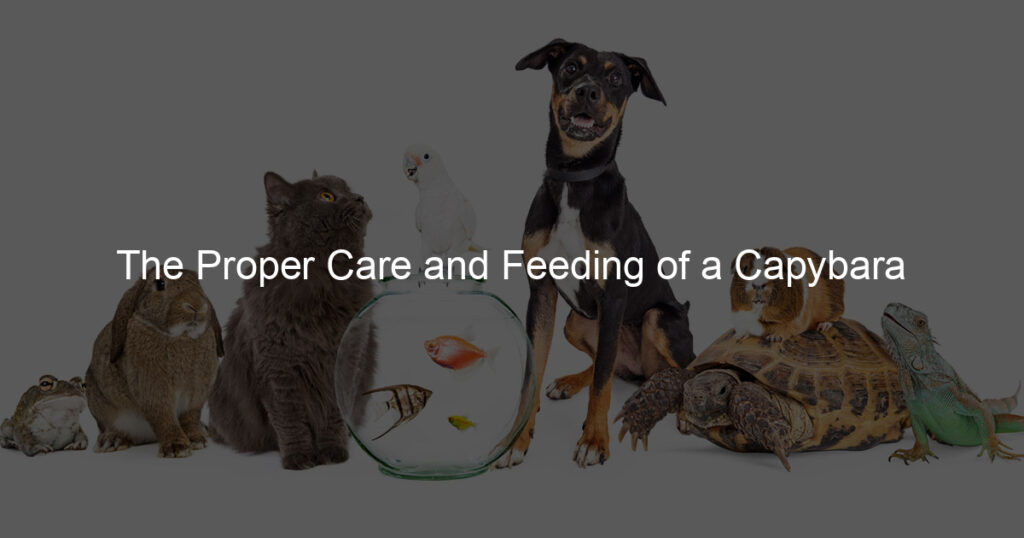If you love animals, then you’ll probably want to know all about the proper care and feeding of a capybara. These unique creatures are native to South America, and they’re known for being friendly and social. Here’s everything you need to know about keeping your pet capybara happy and healthy.
Is taking care of a capybara easy?
The short answer is no, taking care of a capybara is definitely not easy. These large rodents require a skilled and experienced owner to meet their needs for appropriate socialization, space, and diet. They need to be provided with an enriched environment with plenty of straw for bedding and objects for them to play with.
Proper nutrition is critical for the health and well-being of a capybara; they should be fed high-quality hay, fresh vegetables, and some fruits. In addition to food, regular exercise is necessary as well as access to clean water at all times. As long as its owners are prepared to provide the required level of attention and commitment, taking care of a capybara can be incredibly rewarding!
How do you take care of a capybara?
Taking care of a capybara is no easy feat. All curious minds need to understand that capybaras come from tropical countries and climates, so they require a temperature-controlled environment. To keep these cute critters healthy and content, they should be provided with ample space to explore, access to an ample amount of clean water, and plenty of high-fiber grasses and hay for nutrition.
Additionally, capybaras are social creatures so it’s important to provide them with companionship or an engaging activity like swimming in cooler weather environments. To build trust and create a safe haven for their pet, owners must ensure that their enclosure has escape-proof barriers and working locks; furthermore, providing outlets for exploration such as hide-aways would help encourage interaction between family members and the Capybara.
How do you feed a capybara?
Feeding a capybara is relatively simple and inexpensive. High-quality timothy hay makes up the base diet for the animal; it should have access to this type of hay at all times, as it is necessary for its digestive system to function properly. Additionally, a dry mix of miscellaneous grains, pellets, and seeds will provide the protein and fiber that capybaras need in order to remain healthy.
To supplement this main food source, fruits, greens, boiled eggs, cooked vegetables, aquatic plants, and fish can also be given – however, moderation and variety are key! Capybaras also enjoy when their owners offer treats such as squash and sweet potatoes every now and then. Keeping in mind not to give anything sugary or fatty can help ensure that your pet has the best nutrition possible.
How do capybaras eat their food?
Capybaras are unique creatures, and their diet reflects this. Capybaras are herbivores, eating mainly grasses and aquatic plants like water hyacinths, but they also eat fruit, tree bark, and corn. They have an interesting way of eating food–they will stand in the water while sinking their head below the surface to access aquatic plants, wade in shallow bodies of water to get access to grasses and walk on land to reach fruits or other off-the-ground vegetation.
Their incisors and flat molars allow them to cut through, chew, and grind all the different types of food they come across. This diet gives capybaras a chance to acquire all the nutrients they need from various sources.
What is a capybara’s favorite food?
The capybara, the world’s largest rodent, enjoys an interesting and varied diet. These semi-aquatic creatures are native to South America and feed on grasses, aquatic plants, fruits, melons, and roots. They supplement their vegetable diet by occasionally munching on bugs or small fish they can find in their watery habitat.
One of the capybara’s favorite snacks is an aquatic plant called amaranth – they can often be seen snacking on this tasty treat while floating lazily along a river!
What helps a capybara survive?
To survive in the wild, capybaras have several special abilities and strategies. Firstly, their hyper-sensitive hearing helps them detect predators from far away, enabling them to hide quickly. Secondly, their sharp claws allow them to dig burrows in the soft mud of their native habitats. This provides not only protection from predators but also a moderated environment; favorable temperatures and increased moisture help keep the heat at bay during the dry season.
Lastly, as semi-aquatic animals, capybaras have excellent swimming abilities that enable them to pursue prey and escape predation both on land and in water. These skills ultimately give capybaras an edge that enables them to thrive even in extreme climates.
Conclusion
A capybara is a Gentle Giant that can make a great pet for the right person. They are social animals that need companionship, so it’s important to have another capybara or at least another animal friend with them to interact. They also require a lot of space – at least an acre – and a safe place to swim. With the proper care and attention, a capybara can be a wonderful addition to your family.








